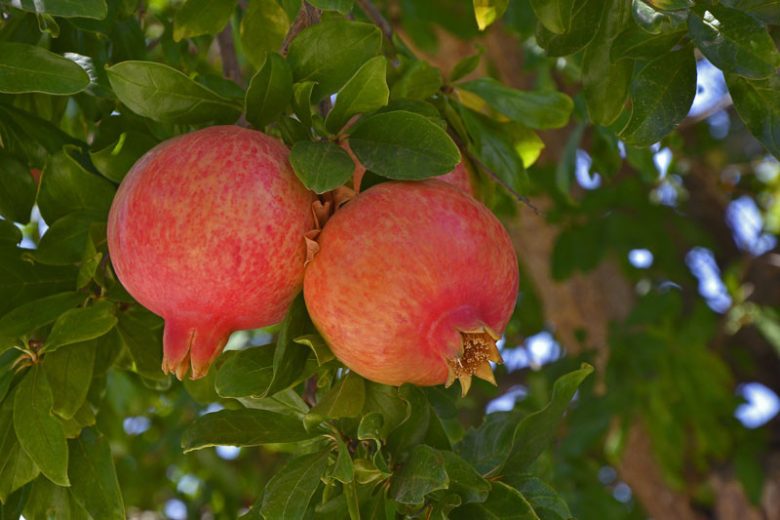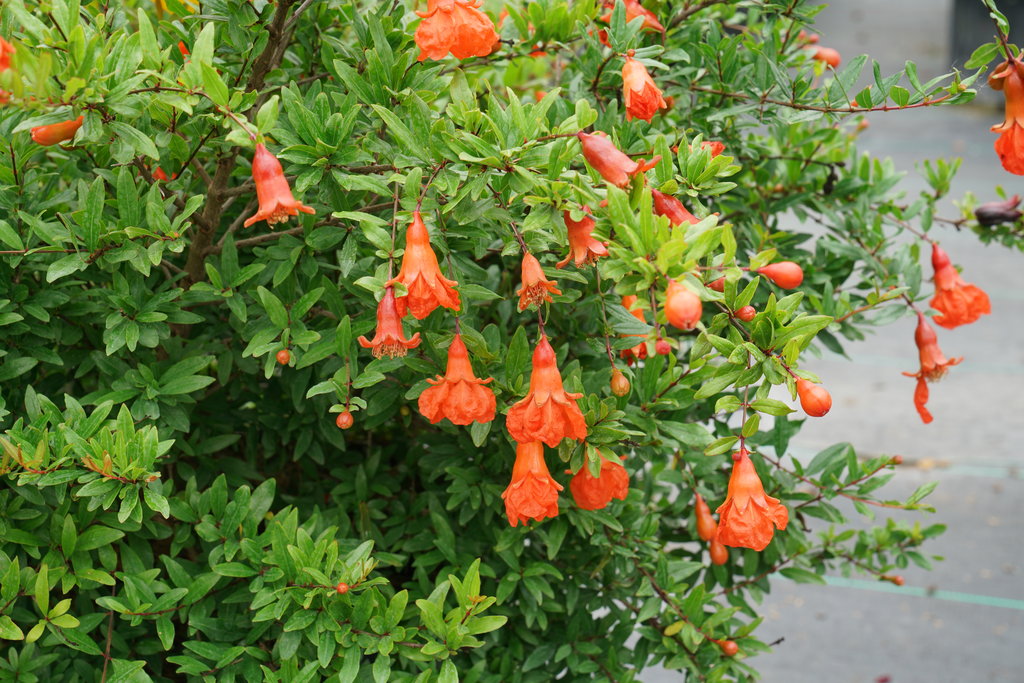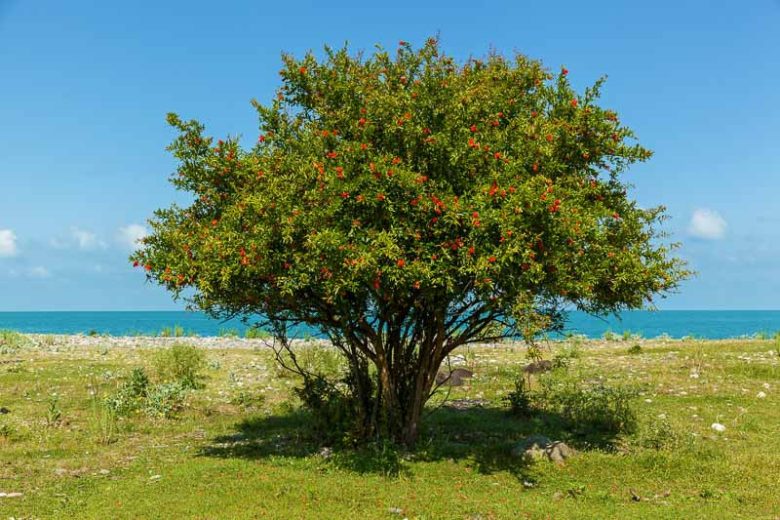Punica Granatum: Podrobný Průvodce Granátovým Jablkem a Jeho Neuvěřitelnými Vlastnostmi
Granátové jablko, vědecky známé jako Punica granatum, je fascinující ovoce s bohatou historií, širokým spektrem využití a pozoruhodnými zdravotními přínosy. Tento detailní průvodce vás provede vším, co potřebujete vědět o této výjimečné rostlině, od jejího původu a botanických charakteristik až po její pěstování, kulinářské aplikace a léčivé vlastnosti.
Botanická Charakteristika Punica Granatum: Hluboký Ponor do Světa Granátovníku
Punica granatum patří do malé čeledi Lythraceae (kyprejovité). Je to opadavý keř nebo malý strom, dorůstající výšky 5 až 10 metrů. Jeho větve jsou trnité a listy lesklé, úzce obvejčité až eliptické, dlouhé 3 až 7 cm a široké 1 až 2 cm. Květy granátovníku jsou nápadné, jasně oranžovo-červené, s pomačkanými okvětními lístky a mnoha tyčinkami. Vyskytují se jednotlivě nebo v malých skupinách na koncích větví.

Morfologie Květů a Plodů Granátovníku: Mistrovské Dílo Přírody
Květy Punica granatum jsou oboupohlavné, což znamená, že obsahují jak samčí (tyčinky), tak samičí (pestík) pohlavní orgány. Kalich je trubkovitý, kožovitý a vytrvává i na plodu. Koruna se skládá z 5 až 8 (někdy i více) volných, nápadných okvětních lístků. Tyčinek je mnoho a jsou uspořádány v několika kruzích. Gyneceum (samičí část květu) se skládá z dolního semeníku s několika komůrkami obsahujícími mnoho vajíček. Plodem je kulatá bobule, známá jako granátové jablko, o průměru 5 až 12 cm. Jeho vnější slupka je kožovitá, zbarvená od žluté přes oranžovou až po tmavě červenou. Uvnitř plodu se nachází mnoho semen obalených šťavnatou, průsvitnou dužinou, která tvoří jedlé části granátového jablka.
Anatomie Semen a Dužiny: Skrytý Poklad Granátového Jablka
Semena Punica granatum jsou tvrdá, hranatá a obklopená jasně červenou, růžovou nebo nažloutlou šťavnatou vrstvou zvanou aril. Arily jsou vlastně zdužnatělé vnější vrstvy osemení. Uvnitř plodu jsou semena a arily uspořádány v několika komůrkách oddělených blanitými přepážkami. Počet semen v jednom granátovém jablku může být značný, někdy i přes 600. Dužina je bohatá na cukry, organické kyseliny, vitamíny a antioxidanty, což z ní činí nejen chutnou, ale i velmi zdravou potravinu.
Variabilita Odrůd Granátového Jablka: Pestrost Tvarů, Barev a Chutí
Existuje mnoho odrůd Punica granatum, které se liší velikostí plodů, barvou slupky a dužiny, chutí (od sladké po kyselou) a počtem semen. Některé odrůdy jsou pěstovány pro přímou konzumaci, jiné pro výrobu šťávy nebo oleje. Mezi známé odrůdy patří ‚Wonderful‘ (s velkými, tmavě červenými plody a sladkokyselou chutí), ‚Ruby Red‘ (s intenzivně červenou dužinou a sladkou chutí), ‚Pink Satin‘ (s růžovou dužinou a jemnou chutí) a ‚Granada‘ (odrůda s vysokou výnosností a dobrou skladovatelností). Každá odrůda má své specifické vlastnosti a je vhodná pro různé účely.
Genetika a Šlechtění Granátovníku: Cesta k Lepším Vlastnostem
Šlechtění Punica granatum se zaměřuje na zlepšení různých vlastností, jako je velikost a kvalita plodů, odolnost vůči chorobám a škůdcům, přizpůsobivost různým klimatickým podmínkám a obsah bioaktivních látek. Genetický výzkum pomáhá identifikovat geny zodpovědné za tyto vlastnosti a umožňuje tak cílenější šlechtění. Moderní šlechtitelské postupy zahrnují křížení vybraných odrůd a selekci potomstva s požadovanými charakteristikami. Díky těmto snahám se neustále objevují nové a vylepšené odrůdy granátového jablka.
Historie a Původ Punica Granatum: Cesta Granátového Jablka Časem a Prostorem

Historie Punica granatum sahá tisíce let do minulosti. Původně pochází z oblasti Blízkého východu, konkrétně z Íránu a okolních zemí. Granátové jablko bylo ceněno již ve starověkých civilizacích, včetně Egypťanů, Řeků a Římanů. Bylo symbolem plodnosti, hojnosti a věčného života. Zmínky o něm se nacházejí v mnoha starověkých textech, včetně Bible a Koránu.
Granátové Jablko ve Starověkých Civilizacích: Symbolika a Význam

V starověkém Egyptě bylo granátové jablko pohřbíváno s mrtvými, aby jim zajistilo posmrtný život. Bylo také považováno za posvátné ovoce a často zobrazováno v umění. Staří Řekové spojovali granátové jablko s bohyní Afroditou a věřili, že má afrodiziakální účinky. Římané ho přivezli do Itálie a rozšířili jeho pěstování po celé své říši. Granátové jablko bylo také důležitou součástí tradiční medicíny v mnoha starověkých kulturách.
Šíření Granátového Jablka Světem: Od Starověku po Současnost
Postupem času se Punica granatum rozšířila z Blízkého východu do Středomoří, severní Afriky, Indie a Číny. S evropskými kolonizátory se dostala i do Ameriky, kde se jí daří zejména v suchých a teplých oblastech, jako je Kalifornie a Arizona. Dnes se granátové jablko pěstuje v mnoha zemích s vhodným klimatem po celém světě a je stále oblíbenější díky své chuti a zdravotním přínosům.
Archeologické Nálezy a Písemné Zmínky: Důkazy Dlouhé Historie
Archeologické nálezy, jako jsou zbytky granátových jablek v starověkých hrobech a vyobrazení na starověkých artefaktech, svědčí o jeho dlouhé historii a významu. Písemné zmínky o granátovém jablku se nacházejí v mnoha starověkých textech, včetně egyptských papyrů, řeckých spisů a římských zemědělských příruček. Tyto historické prameny poskytují cenné informace o tom, jak bylo granátové jablko vnímáno a využíváno v minulosti.
Kulturní Význam Granátového Jablka: Tradice a Symbolika v Různých Kulturách
Granátové jablko má významné postavení v mnoha kulturách po celém světě. V některých kulturách je symbolem plodnosti a prosperity, v jiných představuje štěstí a hojnost. Používá se při různých obřadech a oslavách, například při svatbách a novoročních oslavách. Jeho charakteristický vzhled a chuť ho činí nezaměnitelnou součástí kulinářských tradic mnoha zemí.
Pěstování Punica Granatum: Praktický Průvodce pro Úspěšnou Sklizeň
Pěstování Punica granatum může být poměrně snadné, pokud jsou splněny základní požadavky na klima, půdu a péči. Granátovník preferuje teplé a suché klima s dostatkem slunce. Je poměrně odolný vůči suchu a snáší i chudší půdy, ale nejlépe se mu daří v dobře propustné, hlinitopísčité půdě s pH mezi 6,0 a 7,5.
Výběr Stanoviště a Příprava Půdy: Základy Úspěšného Pěstování
Pro Punica granatum je ideální slunné stanoviště, které je chráněné před silnými větry. Půdu je vhodné před výsadbou prokypřit a obohatit kompostem nebo jiným organickým hnojivem. Pokud je půda příliš těžká a jílovitá, je vhodné přidat písek pro zlepšení drenáže. Před výsadbou je také dobré provést test pH půdy a v případě potřeby upravit její kyselost.
Výsadba Granátovníku: Krok za Krokem k Vlastní Úrodě

Granátovníky se nejčastěji vysazují na jaře nebo na podzim. Před výsadbou je vhodné namočit kořenový bal na několik hodin do vody. Jáma pro výsadbu by měla být dostatečně velká, aby se do ní pohodlně vešly kořeny. Po umístění stromku do jámy zasypte kořeny zeminou a lehce ji přitlačte. Nakonec stromek důkladně zalijte. Při výsadbě více stromků dodržujte rozestupy alespoň 3 až 5 metrů, aby měly dostatek prostoru pro růst.
Zálivka a Hnojení: Klíč k Zdravému Růstu a Bohaté Úrodě
Mladé granátovníky vyžadují pravidelnou zálivku, zejména v suchých obdobích. Starší, dobře zakořeněné stromy jsou odolnější vůči suchu, ale pro optimální růst a plodnost je vhodné je občas zalít, zejména během kvetení a vývoje plodů. Co se týče hnojení, mladé stromky ocení pravidelné přihnojování vyváženým hnojivem pro ovocné stromy. Starší stromy obvykle nepotřebují intenzivní hnojení, ale přihnojení kompostem na jaře může podpořit jejich růst a plodnost.
Řez a Tvarování: Pro Dobrou Vzdušnost a Snadnou Sklizeň
Řez Punica granatum se provádí hlavně pro udržení tvaru stromu nebo keře, zajištění dobré vzdušnosti a prosvětlení koruny, což podporuje tvorbu plodů a snižuje riziko chorob. Odstraňují se suché, poškozené nebo křížící se větve. U mladých stromků se provádí výchovný řez, aby se vytvořila silná a dobře rozvětvená koruna. U starších stromů se udržovacím řezem odstraňují staré a málo plodné větve a zahušťující výhony.
Zdravotní Přínosy Punica Granatum: Pokladnice Přírodních Léků
Punica granatum je známá svými výjimečnými zdravotními přínosy, které jsou dány vysokým obsahem antioxidantů, vitamínů a minerálních látek. Pravidelná konzumace granátového jablka a jeho produktů může přispět k prevenci mnoha chronických onemocnění a podpořit celkové zdraví.
Antioxidační Síla Granátového Jablka: Boj proti Volným Radikálům
Granátové jablko je jedním z nejbohatších zdrojů přírodních antioxidantů, jako jsou punikalaginy, antokyany a taniny. Tyto látky pomáhají neutralizovat volné radikály v těle, které mohou poškozovat buňky a přispívat k rozvoji mnoha onemocnění, včetně srdečně-cévních chorob, rakoviny a Alzheimerovy choroby. Vysoký obsah antioxidantů v granátovém jablku může také přispět k zpomalení procesu stárnutí.
Protizánětlivé Účinky: Přirozená Pomoc při Zánětlivých Onemocněních

Studie prokázaly, že extrakty z Punica granatum mají silné protizánětlivé účinky. Mohou pomoci snižovat zánět v těle, který je spojen s mnoha chronickými onemocněními, jako je artritida, zánětlivá střevní onemocnění a některé typy rakoviny. Protizánětlivé vlastnosti granátového jablka jsou přisuzovány především vysokému obsahu punikalaginů.
Podpora Kardiovaskulárního Zdraví: Ochrana Srdce a Cév
Pravidelná konzumace granátového jablka může mít pozitivní vliv na kardiovaskulární systém. Studie naznačují, že může pomoci snižovat krevní tlak, hladinu cholesterolu a triglyceridů v krvi, a tím snižovat riziko srdečních onemocnění a mrtvice. Antioxidanty v granátovém jablku také pomáhají chránit cévy před poškozením.
Potenciál v Boji proti Rakovině: Nadějné Výsledky Výzkumů

Některé laboratorní studie a studie na zvířatech naznačují, že extrakty z Punica granatum mohou mít protirakovinné účinky. Bylo prokázáno, že inhibují růst rakovinných buněk u různých typů rakoviny, včetně rakoviny prostaty, prsu, plic a tlustého střeva. Je však třeba provést další výzkumy na lidech, aby se tyto předběžné výsledky potvrdily.
Využití Punica Granatum v Kuchyni: Kulinářská Inspirace s Granátovým Jablkem
Punica granatum je nejen zdravé, ale i velmi chutné ovoce s širokým využitím v kuchyni. Jeho sladkokyselá chuť a šťavnatá semínka dodají jedinečný charakter mnoha pokrmům a nápojům.